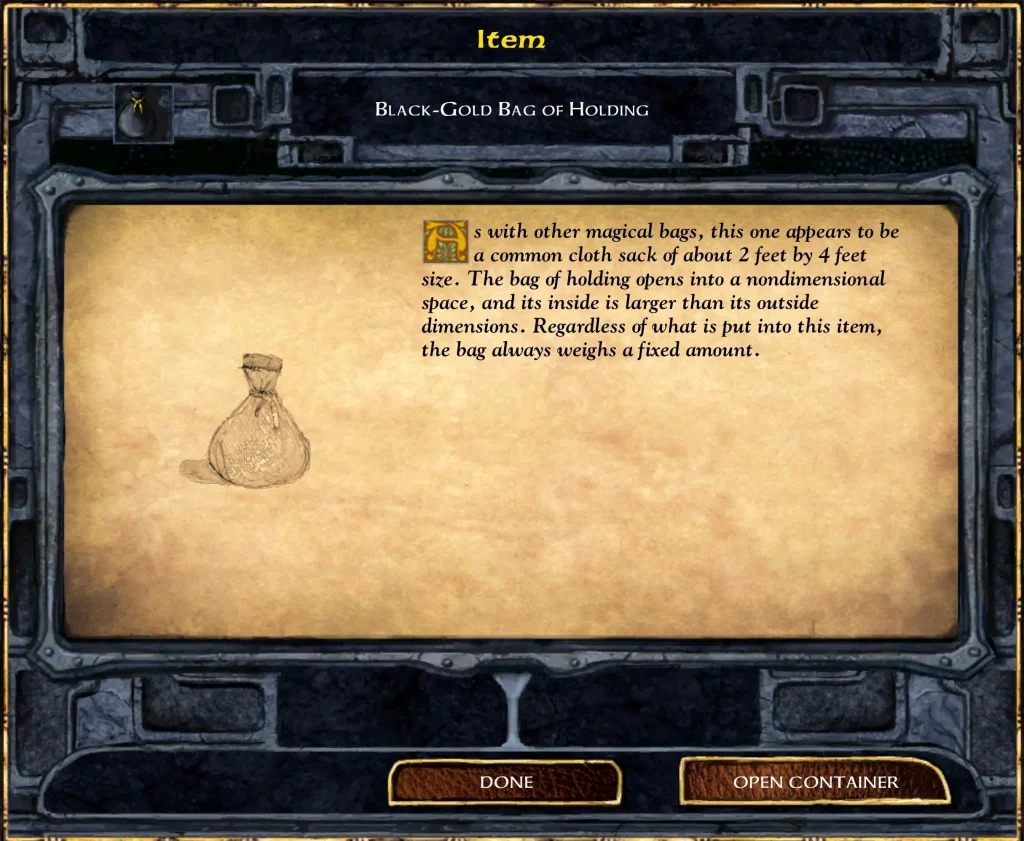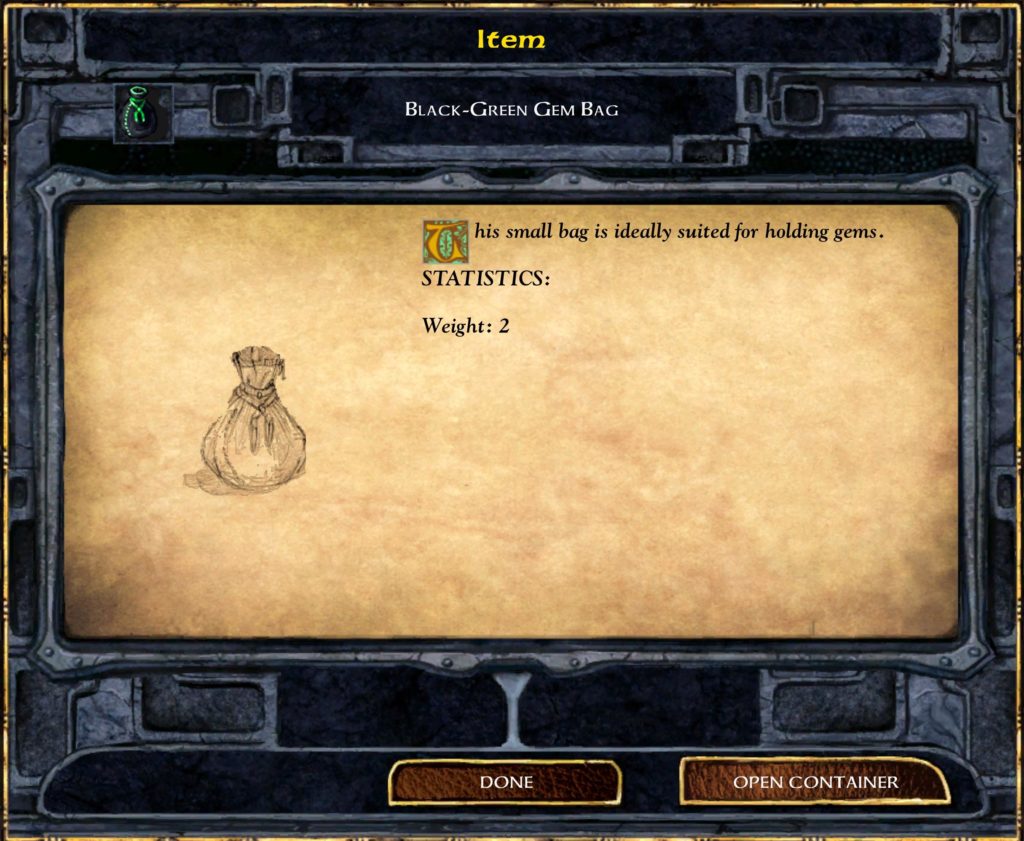For a while now I’ve been playing a heavily modded version of the Baldur’s Gate Trilogy where I make use of modded container items. Inventory management not only changes how you play the game, but it also impacts the progression of the character, as well as the player’s immersion into the game.
I’m currently disconnected so I don’t have any time to play games right now. So instead of the usual Let’s Play article, I’ve written up a short article on gameplay.
Inventory Management
If you have played any game with RPG elements (which is most games these days), you will have come across a mechanic that is near universal: Inventory Management. Inventory management can be an important tool in the design of a game. Sid Meier famously said that a game is a “series of interesting choices”. If we take this definition to heart, then inventory management can force a player to make those interesting choices.
Should the player hoard treasure, or leave it behind to save space for more valuable items further down the road? What tools should the player bring on this mission/quest and what tools should they leave behind? Does the player want to risk losing this item permanently, or keep it in storage for safekeeping? Which character needs this item more?
These choices need to matter to the player. The joy of discovering a rare treasure or magic item, the sense of loss at losing an important item, the need to suppress our natural desire to hoard items “just in case”, the regret at realising you should have kept that item because you could really use it right now. A well designed system will eventually impact the player’s emotional response to a game.

Some games simply allow you to pick up as many items as possible and use them as needed. This is common in adventure games like Day of the Tentacle, where the total number of items in the game is limited, and each item has a specific use at a specific point of the game.
Traditionally, however, games will have a limited inventory space, forcing the player to choose what items they carry and what items they leave behind, be it in a chest or just lying on the ground. Minecraft makes use of this kind of inventory management, allowing the player to build chests so they can store more items, but limiting what they can carry around on their avatar.

Baldur’s Gate
Baldur’s Gate uses a similar mechanic, although it adds an extra layer of management: weight. Each character is limited both by the number of slots available, and by the weight of each item. The maximum weight a character can carry is based on their Strength score. A weak gnome mage may only be able to wear robes and carry a few scrolls, whereas a strong half-orc warrior can wear full plate mail armour and carry a large broadsword.

Baldur’s Gate doesn’t allow the player to create chests, however there are plenty of chests around for players to store items for later use if they desire. This doesn’t help when exploring the wilderness, however. In Baldur’s Gate, enemies will drop all of their mundane items alongside any gems they may have. Short swords, leather armour, sling bullets, and so on.
The player could collect all of these to sell to a merchant later, but they will quickly run out of both inventory space and become over-encumbered with heavy equipment. Players will learn that the best things to pick up are the small, lightweight gems and jewellery that hold greater value to merchants, as well as any magic items they come across.
They will even learn what kinds of trinkets to keep. Silver jewellery is less valuable, but emeralds, diamonds, and pearl necklaces will fetch a good price. Hunting ankheg shells or wyvern skulls can also prove profitable, though these are much heavier than gems.
Inventory management is a huge part of Baldur’s Gate‘s first installment. However, as the player progresses through Shadows of Amn and into Throne of Bhaal, they will find items that start to change the way they approach inventory management.
Bag of Holding et al.
In Shadows of Amn, a few new items become available that allow the party to carry more items. Among these are the Bag of Holding, that can hold anything; the Gem Bag, that can hold gems and jewellery; the Potion Case for potions; and the Scroll Case for scrolls. Throne of Bhaal also introduced the Ammo Belt that can hold all types of ammo.

An important thing to note about all of these container items is that any items stored in them no longer have any weight. If you have 8 ankheg shells they are usually difficult for a party to carry due to their weight and inability to stack them, a Bag of Holding will remove these restrictions at the cost of a single inventory slot.
These new items impact the game in a couple of ways. First: it changes how a player approaches inventory management. Second: it changes how the world and the characters actually feel to the player; gaining these items reflects the growth of the characters. I go into detail on each of these effects in the following sections.
Impact on Gameplay
With these items the player no longer needs to think as much about what treasures to keep and which ones to pass over. Now, the player can simply grab all 23 halberds from those gnoll corpses, stuff them in the Bag of Holding, and doesn’t need to worry about how much they weigh or how many inventory slots they take up. They may not fetch much when sold, but every gold piece helps toward the “Save Imoen Fund”.

With this change, much of the inventory management is slowly removed from the game as the player progresses through Shadows of Amn. Once the player has the Bag of Holding, they no longer need to worry about encumbrance and inventory slots for the most part. Now, the player is free to compose a party of weak characters and not worry about weight restrictions. A high-Strength character is no longer a necessity, at least in terms of hoarding valuable items.
This is, I believe, intentional on the part of the developers. The characters in the game are supposed to be gaining more power and will eventually reach a point where gold has no meaning and the choices provided by inventory management are no longer interesting. They will have most of the best equipment available and will only need to restock potions and ammo.
Relieving the player of inventory management, allows them to focus more on improving their characters and preparing for tougher battles. It’s a shift in gameplay style that continues well into Throne of Bhaal.
Effect on Immersion
In Baldur’s Gate I you are young, barely an adult, forced out into the world alone. You have to carefully choose your allies, where you travel, and how you manage your equipment. During Shadows of Amn you start to become more powerful, and armed with much better equipment. By the time of Throne of Bhaal you will be approaching your peak, and gold will be almost unlimited.

As a young man wandering the wilderness, every item matters. Every Potion of Healing, every arrow, every unbroken sword can be a useful thing to hang onto. By limiting the amount you can carry the game reinforces that the character has difficult choices ahead of them.
By the time of Throne of Bhaal barely anything you find will improve upon your Flail of Ages, or whatever weapon you yield. You are approaching godhood, and sifting through mundane weapons and trinkets is no longer a concern. By giving you container items the game removes these concerns from you as a player, reflecting the in-world growth of the characters.
The shift in the mechanics of inventory management reflect the character’s growth through the series, allowing a more immersive experience for the player.
Changes in the Enhanced Edition
The Enhanced Edition of the game did bring a few of these items back into the first part of the trilogy. Players will be able to find the Gem Bag, Potion Case, and Scroll Case in the early stages of the game when playing the Baldur’s Gate: Enhanced Edition.
I mentioned above how difficult choices can elicit an emotional response. One of those choices is which items to keep, and which to leave behind. In Baldur’s Gate players will learn that some gems and jewellery are worth more than others, and choose which gems to keep based on their value. With the Gem Bag, this choice no longer matters. Players can simply hoard all the gems and jewellery, selling it to the next vendor they come across.

Another choice is what items to take with you on a quest and which to store for safe keeping. Storing potions and scrolls away at a base, be it in Beregost or Baldur’s Gate, is a common tactic. With the Potion Case and Scroll Case this is no longer a choice that needs to be made. All potions and scrolls the player has come across will always be available.
I can’t know why Beamdog made these changes, but I can make an intelligent guess. Baldur’s Gate can be a brutal game, especially for newcomers. Some people will embrace that challenge, but it isn’t for everyone. One of Beamdog’s goals was to make the game more accessible to new players, and this was almost certainly a consideration when moving these items earlier in the progression.
This is why there is a Story Mode in the Enhanced Edition, a way of playing the game with very little/no challenge. Some people just want a fun experience rather than a hardcore challenge. So perhaps Beamdog thought the inventory management had too many pain points with little reward, and wanted to make things easier for players in general.
The Scroll Case and Potion Case allow players to not have to think about what they bring with them when they leave a town – rather than forcing them to choose and return to Beregost bleeding when they realise they need different spells and potions. The Scroll Case makes more sense, as mages are particularly weak in Baldur’s Gate, so giving them access to all scrolls all the time gives them more of a bite.

The Gem Bag removes the player’s need to decide which gems to keep and which to leave behind. The lower cost jewellery that you leave behind won’t be worth enough gold to have a huge impact on the player’s progression so perhaps it’s a choice that Beamdog didn’t think was necessary.
Beamdog likely didn’t add the Bag of Holding and Ammo Belt because these items genuinely do have a larger impact on the game. Not having to worry about space for ammo anymore, or being able to hoard items with impunity, would completely remove inventory management from the game altogether.
One thing I do notice with this change is that there is a positive impact on immersion. During Baldur’s Gate (and Siege of Dragonspear) you will get used to using these containers. When you wake up in Irenicus’s cell in Shadows of Amn you don’t have these items anymore. You are back to square one, having to make difficult choices and building yourself back up again. This improves the feel of being locked away and stripped back down that Shadows of Amn is aiming for in its beginning.
For better or for worse, the changes to inventory management have clearly been thought out by Beamdog. While the addition of these items to the Enhanced Edition do make the game easier and remove some choices, it could be argued that these choices were uninteresting to begin with. There are still many interesting choices for the player to make, and it even adds a little more impact when the player moves into Shadows of Amn.




